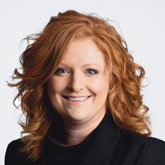Nursing Workforce 2.0 Summit elevates new thinking, reinforces values
More than 30 participants from 10 health systems came together in March for HealthTrust’s Nursing Workforce 2.0 Summit. It was a day of learning and ideating on how to leverage technology and innovation within the constraints of nurse staffing and workload. Participants enjoyed one-on-one dialogue with five technology suppliers, heard from experts and peers, networked with colleagues and formed 90-day action plans for their organizations.

“Workforce burnout is a universal problem that threatens to shut down our industry,” says Stephanie Thompson, PharmD, MBA, VP of Clinical Services at HealthTrust. She oversaw the coordination of the summit following the initial summit held in February of 2023.
“Physicians, pharmacists, patient care techs, nurses, EVS staff, supply chain professionals—COVID put them all through the wringer,” says Thompson. But no position has taken more of a hit than the bedside nurse, without whom patient care cannot happen. “Everything else becomes a moot point when providers don’t have staff to execute care at the bedside.”
The pandemic exacerbated problems that have tested the nursing workforce for some time. Long hours, stress, fear of the unknown and workplace violence escalated enormously. “Consider nurses new to the workforce who were suddenly facing a public health disaster. Many felt as if the stress of a pandemic was not what they signed up for. The pandemic not only pushed some of these new nurses out of healthcare altogether; it also saw tenured nurses retiring in droves,” explains Thompson. Suddenly, a company like Amazon became a competitor for labor because it could afford to pay better and offer more flexible hours, often through positions that enable employees to work remotely.
“Not everyone can be a bedside nurse,” adds Thompson. “It can’t just be perceived as a well-paying job; individuals must be born with a passion to do this work.” Health systems must figure out how to find people who are true caregivers and nurture their passion in ways they haven’t done before.
Mercy creates its own “gig” workforce

Beth Melgren, Director, Clinical Operations, at the St. Louis-based Mercy Health system, showcased an innovative solution they have implemented to help with nurse workforce staffing at one of the largest health systems in the U.S.
To combat the nursing shortage, Mercy uses a creative approach with technology to get more nurses at the bedside. The 51-hospital health system partnered with Trusted Health to build a mobile platform that enables nurses to pick up shifts in an Uber-like model. Using an app on their smartphones, nurses can easily view available shifts and select what works for them in terms of when and where. They can also view the hourly pay rates before making their selection.
“Coming out of the pandemic, we looked at generational differences and what motivates them to work,” shares Melgren. “We’ve discovered that money is not always the key driver to folks picking up additional shifts.” From these conversations, a new workforce layer—the “gig” workforce—emerged. All Mercy nurses—whether they’re part of the core workforce, flex workers (PRN, float pool) or gig workforce—can pick up shifts using the app.
This strategy has helped Mercy significantly decrease its dependency on agency nurses. In the first year, agency staff was reduced from 25% to 8%. “We use AI and technology in the background to establish rates and dynamic pricing so that we offer the highest dollars where and when there is the highest need,” explains Melgren. Priority is given to core nurses, then float pool, then gig.
“Introducing the gig layer has successfully unlocked flexibility in our nursing workforce,” adds Melgren. Requirements are like those listed by an agency; a nurse must have experience in the area and have active certifications to qualify for a given opening. Gig nurses are hired and onboarded in the same manner as other nurses so if they decide they want to move to full time, there is no delay and no doubt that they are a good fit. In another nod to flexibility, nurses who want to take an agency contract can transition to a gig role to maintain their seniority when they decide to return.
“We are offering nurses the flexibility they need, at whatever stage of their life, while still remaining connected to Mercy,” says Melgren. And it’s resulted in cost savings to the health system. The program is working so well that Melgren and her colleagues are expanding the new gig workforce model to respiratory therapy and imaging, where there are also staffing shortages.
Innovating without disrupting patient care
When hospitals implement new technology or other innovations, it often disrupts the frontline nurse’s focus on patients. For innovation and technology to work, frontline staff must be at the table from the start because they know the problems best.
Summit keynote speaker Michael Burcham, Chief of Strategy and Talent Development at Shore Capital Partners, delivered insights on how to realistically innovate within the boundaries of the highly regulated healthcare industry. An important step, he explained, is ensuring you create an environment where innovation can happen, such as making sure that frontline staff are well represented on a newly formed multidisciplinary team.

For Darius Love, AVP of Workforce Optimization at Orlando Health, an important takeaway from the summit was the discussion around building teams with complementary skill sets to drive innovation. “My team and I left the summit with a plan for how we were going to leverage technology to roll out virtual nursing across our enterprise,” says Love. They have already had strong wins at two of their community hospitals in terms of patient experience outcomes, time saved and administrative tasks removed from the bedside clinician to the virtual clinician.
“I found the summit powerful because it was a gathering of not only thought leaders, but also operational and strategic leaders,” shares Love. “It helped us all understand that we’re not alone in facing these issues and that there are solutions and effective approaches.”
“There are problems that technology doesn’t solve for,” says Thompson. “What does seem to work is coming together with peers from across the country to discuss new approaches to the issues they’re dealing with. These summits affirm the power in collaboration.”
Share feedback on your biggest challenges and help shape our next Collaborative Summit. Email your suggestions to clinical.services@healthtrustpg.com or post to the HealthTrust Huddle.
Share Email Nursing, Q3 2024, Staffing





